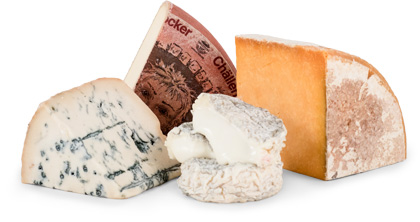To find the source of the third of this month’s featured cheeses, head southwest from the Alps, cross the Pyrenees and stop once you find yourself in the famed Spanish province of Zamora, in the Autonomous Community of Castilla y Leon. For over a century this region, located northwest of Madrid, has earned praise and enjoyed fame for its fantastic ewe’s milk cheeses. You’re probably already familiar with Manchego cheese, Spain’s best-known sheep’s milk cheese. However, you may not be as well acquainted with another variety, made much the same way, which has likewise been adored by locals and the international community for more than 100 years. Made from the milk of the Castilian and Churra breeds of sheep native to this province, this pressed cheese has a distinctive, slightly piquant flavor, which is full-bodied and lingers on the palate.
As with all cheese, the flavor of Zamorano comes from a unique combination of terrestrial elements, which ultimately influence both the milk of the animals from which it is made and the traditions of the people who create it. The continental climate of this region of Spain provides abundant pastures upon which the two breeds of sheep feed. In fact, there are some 60,000 animals registered at the Regulating Council, a body that governs various aspects of cheese production, including, as the name implies, strict regulation of the cheese-making process which has been protected by the Denomination of Origin since 1993. The sheep produce a hefty volume of milk annually; over four million gallons are used exclusively for cheese (which is, if you can believe it, only about one-quarter of their total annual production), yielding over 330 tons of Zamorano cheese per year. Again, we can thank these two breeds of Spanish sheep for this delicacy, as it’s no small task to produce the amount of milk necessary to satisfy the world’s craving for this wonderful cheese. Once the milk is ready (free of colostrum that could adversely affect production), cheese processing can begin, and is carried out in compliance with the following steps, as mandated by the Regulating Council:
1. Curdling: caused by rennet (an enzyme-containing coagulant that produces the curd) at a temperature of 82 to 90°F. The curdling time is between 30 and 45 minutes.
2. Cutting and Heating: The resulting curd is cut several times and then stirred during a gentle warming-up process
3. Moulding and Pressing: Specific moulds give this cheese its characteristic cylindrical shape.
4. Salting: May be humid or dry, and at times both forms are used together.
5. Aging and Preservation/Curing: The minimum duration is no less than one hundred days, starting with the day of moulding. Some facilities still use the famed caves of the region that are distinctively cold and humid.
Despite the large amount of cheese produced per year, the meticulous attention paid to the processing stages and methods ensures consistent flavor and quality. But it wasn’t always produced in this highly regulated form. This cheese was originally made and developed by essentially nomadic families who would move from place to place throughout the Castillian countryside, taking their flocks of sheep with them to each new grazing land. Wherever they would settle for the time being, they would unpack their cheese-making utensils and spend months making their goods. When they would finally return to their home province of Zamora, they would sell their cheese in local markets but not before leaving some to ripen for extended periods of time in underground cellars or caves. These aged cheeses were later sold at a higher price and/or consumed by the families that produced them.
The season for producing their famed cheese was during the spring and summer months, during which they would make batch after batch that they would then sell or keep through the winter. In the later half of last century, they started settling and building small cheese factories which today are considered “artisan” cheese factories. They’re still worked by many of the same families who have made the cheese for centuries. They follow the same annual rhythm of producing and selling cheeses that their nomadic ancestors did, including curing these unique cheeses in the caves of the Zamoran province.
A well-known and respected Spanish cheese, it is usually produced in the shape of a drum. The cheese is very similar to Castellano and Manchego in texture, but is less grainy. Its natural rind is covered in gray mold. The flavor offers a hint of burnt caramel and the buttery taste of sheep's milk, with some intense, piquant highlights. Zamorano is most frequently enjoyed as a table cheese.

Experience International Variety
You might receive a Gaperon, originating in France during the 14th Century, an
authentic Lancashire by Ruth Kirkham, and an Italian Taleggio matured in the
caves of Valsassina…all in one shipment!

